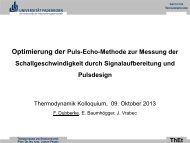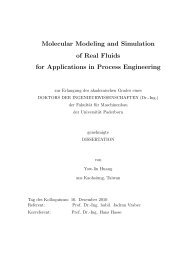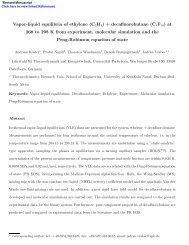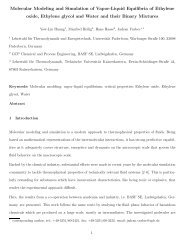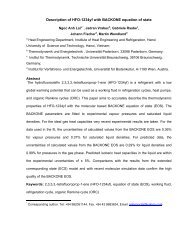ms2: A Molecular Simulation Tool for Thermodynamic Properties
ms2: A Molecular Simulation Tool for Thermodynamic Properties
ms2: A Molecular Simulation Tool for Thermodynamic Properties
Create successful ePaper yourself
Turn your PDF publications into a flip-book with our unique Google optimized e-Paper software.
sense that the specified chemical potentials are not constant, but dependent on the actual pressure of the vapor<br />
phase. However, experience based on hundreds of systems [25, 28] shows that the vapor phase simulation rapidly<br />
converges to the saturated vapor state point during equilibration so that effectively the equilibrium chemical<br />
potentials are specified via the attained vapor pressure. The number of molecules varies during the vapor phase<br />
simulation of the grand equilibrium method. Starting from a specified number of molecules in an arbitrarily<br />
chosen gaseous state, <strong>ms2</strong> adjusts the extensive volumeV after an equilibration period so that the vapor density<br />
does not have to be known in advance.<br />
The grand equilibrium method has been widely used and compares favorably to other methods used <strong>for</strong> vapor<br />
liquid equilibrium simulations, as shown in section 6.<br />
3.2.2. Integrators, thermostat and barostat<br />
In<strong>ms2</strong>, two integrators are implemented to solve Newton’s equations of motion during MD simulation: Leapfrog<br />
and Gear predictor-corrector. These integrators are well known and described in literature [29]. The leapfrog<br />
integrator is a second order integrator that requires little computational ef<strong>for</strong>t, while being robust <strong>for</strong> many ap-<br />
plications. The error of the method scales quadratically with the length of the chosen time step. The Gear<br />
predictor-corrector integrator is implemented with fifth order and is more accurate <strong>for</strong> small time steps com-<br />
pared to the Leapfrog integration [29]. The computational demand <strong>for</strong> both integration schemes is similar as<br />
implemented in<strong>ms2</strong>. The Gear integration, though being of higher order, is only 0.3% slower than the Leapfrog<br />
algorithm <strong>for</strong> the total calculation of one MD time step with a molecular model composed of three LJ sites,<br />
having three rotational degrees of freedom.<br />
For MC, the Markov chain is generated by repeatedly disturbing the system by translational or rotational motion<br />
of a molecule and evaluating the resulting configurations with respect to energy using Metropolis acceptance cri-<br />
terion. The thermostat incorporated in<strong>ms2</strong> is velocity scaling. Here, the velocities are scaled such that the actual<br />
kinetic energy matches the specified temperature. The scaling is applied equally over all molecular degrees of<br />
freedom. The pressure is kept constant using Andersen’s barostat in MD, and random volume changes evaluated<br />
according to Metropolis acceptance criterion in MC, respectively.<br />
3.2.3. Basics on simulations with <strong>ms2</strong><br />
The basic molecular simulation techniques employed in<strong>ms2</strong> are well described in the literature [29, 34, 35] and<br />
are thus not repeated here. All non-standard methods that are implemented in <strong>ms2</strong> are introduced in section 4<br />
or the Supplementary Material. The following paragraph briefly describes the most significant assumptions and<br />
techniques employed in <strong>ms2</strong>.<br />
<strong>Simulation</strong>s with<strong>ms2</strong> are per<strong>for</strong>med in a quasi-infinite Cartesian space, using periodic boundary conditions [36]<br />
and the minimum image convention [37]. The molecular interactions are considered to be pairwise additive,<br />
like in most other simulation packages. Including three- and many-body interactions leads to an increase in<br />
computational ef<strong>for</strong>t while the benefits are questionable. As usual, the computational ef<strong>for</strong>t in <strong>ms2</strong> is reduced<br />
by the introduction of a cut-off radius, up to which the intermolecular interactions are explicitly evaluated. The<br />
contributions of interactions with molecules beyond the cut-off radius are accounted <strong>for</strong> by correction schemes.<br />
7



